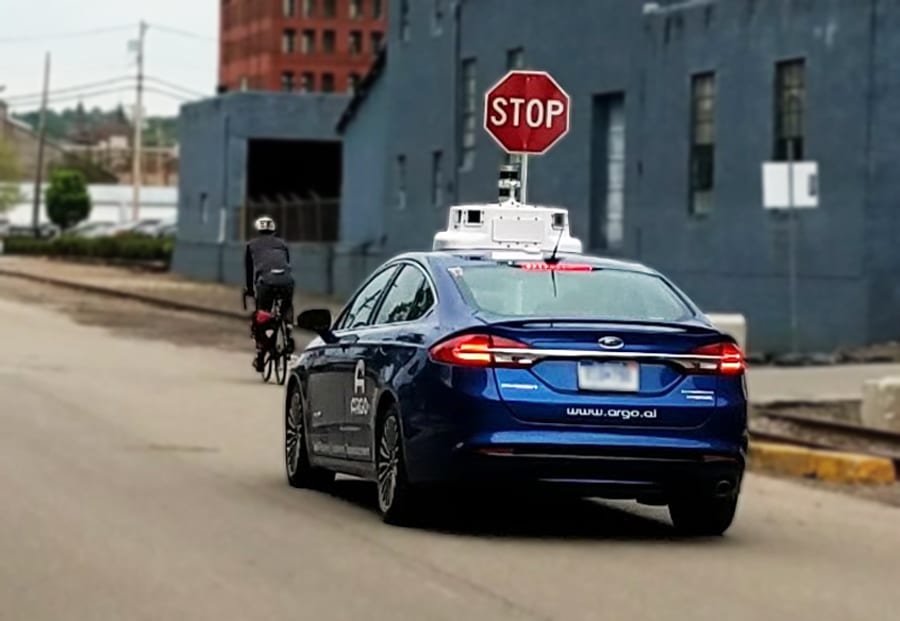
An Autonomous Vehicle and a person on a bike competing for space on Railroad St in the Strip District
Be prepared for even more traffic once Uber’s vehicles return
There is no doubt that the September 2016 launch of Uber’s Autonomous Vehicle testing facility in the Strip District changed the neighborhood forever. Almost immediately, streets like Smallman Street and Penn Avenue were carrying an increasing number of vehicles, many of them autonomous.
AVs quickly became a constant feature on the road. Unfortunately, these are the same roads that serve as the main bike route between Downtown and Lawrenceville/Bloomfield and the eastern neighborhoods.
Autonomous vehicles contribute to traffic and to Pittsburgh’s poor air quality
Then, on March 18, 2018, an Uber AV struck and killed Elaine Herzberg a pedestrian walking a bicycle across a street in Tempe, Az. Uber swiftly ceased all public road testing and pulled their cars from Pittsburgh’s streets.
It didn’t take long for this gap to be filled by Argo AI, a company that has also been testing vehicles in the Strip District and has increased their presence, and number of vehicles, in Uber’s absence. One big difference, though, is that Argo is not only using the bike routes of Smallman Street and Penn Avenue to test their vehicles, they have begun routing them on Railroad Street as well. Railroad Street was once a quiet back street frequented by bicyclists who were frustrated with the state of aggressive drivers and traffic on Smallman Street.
Now, with Argo’s increased presence on Strip District streets, Uber has indicated their imminent plan to return to testing on Pittsburgh’s public streets, the majority of which will be located in the Strip.
While many people feel that AVs treat them better than human driven cars, the sheer increase in vehicles has negatively impacted Pittsburgher’s daily bike commute and air quality. Despite this increase, there has been no change in how the City manages this additional traffic, nor any change in the street design to encourage other modes. To their credit, the City is actively planning some traffic calming measures along Penn Ave to aid pedestrians.
#ExtendPenn Ave Bike Lanes
Bikes are notoriously difficult for AVs to recognize and predict, as evidenced by the tragedy in Tempe. They have a particularly difficult time passing bicyclists and sharing the lane with them. No standard exists, and it’s not even clear how well they “see” people on bikes.
One thing that is known, however, is that not unlike human drivers, autonomous vehicles also have an easier time passing and sharing the road with people on bikes riding in bike lanes.
However, the popular bike lanes that the City provided on Penn Avenue end at the very location that the AV testing begins – the Strip District.
If we allow companies to test autonomous vehicles without planning for or improving our streets for bikes and pedestrians, we are literally putting people in harm’s way.
While we support the Mayor’s proposal to limit AVs to 25mph while in autonomous mode as well as the traffic calming measures on Penn Ave, this doesn’t deal with the sheer number of autonomous vehicles on the road. Additionally, the more AVs that are on the road, the less likely companies will staff each car with two safety drivers – a proven safety protocol.
That’s why we’re calling on the City to extend the Penn Ave bike lanes into the surrounding neighborhoods.
For the past four years, people riding from downtown have enjoyed a great bike lane that ends at 16th St, creating confusion and sending riders to “share the road” on Smallman Street, where they are confronted with aggressive driving, large trucks, and an ever increasing amount of autonomous vehicles.
Whether the ultimate route through the Strip is Penn, Smallman, or the Allegheny Riverfront Green Boulevard, there are lots of options to build this connection, and now is the time to do it.
Sign our petition and tell the City to #ExtendPenn!
